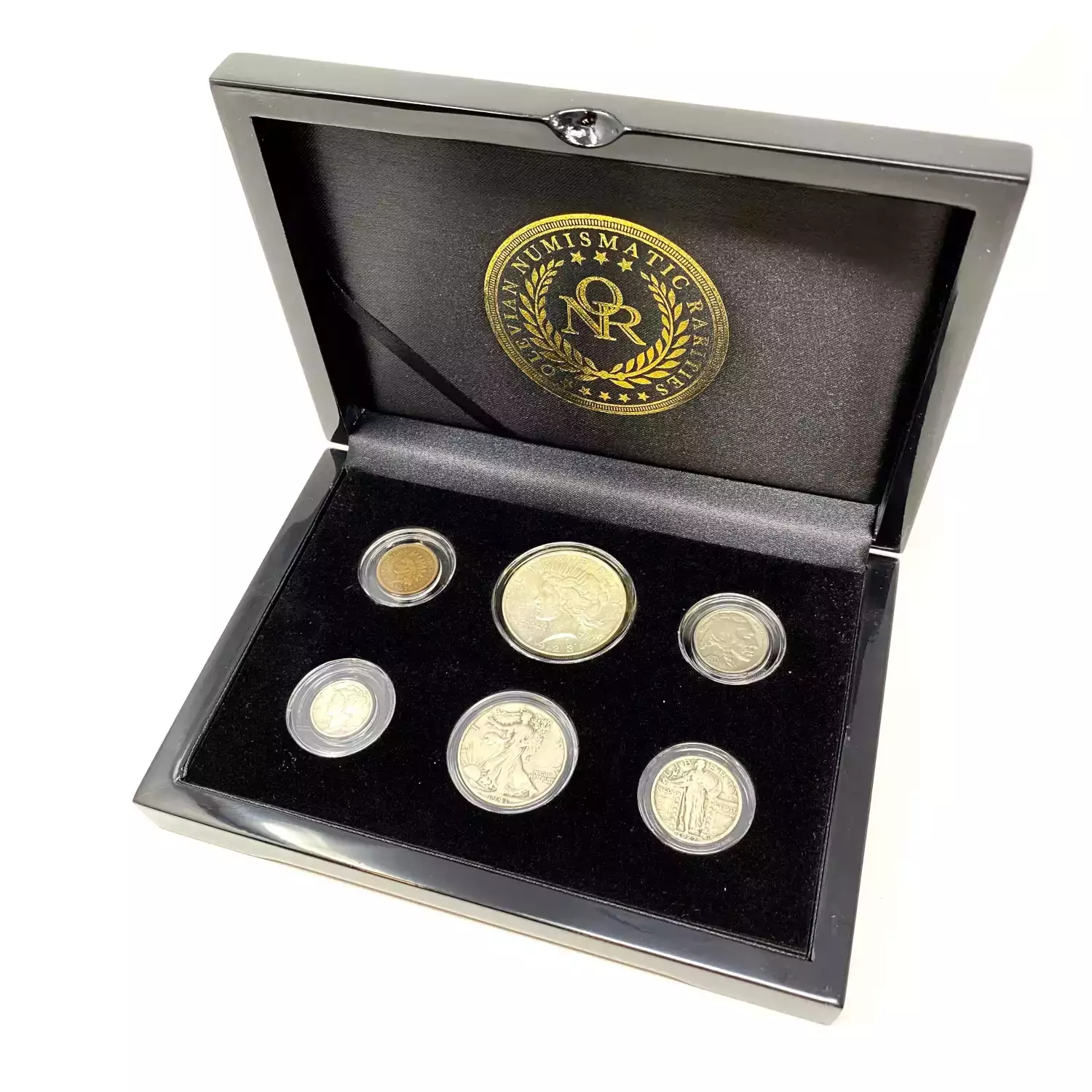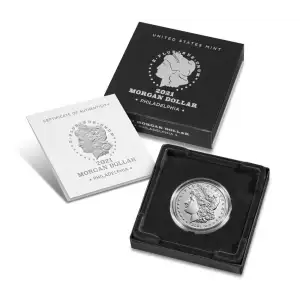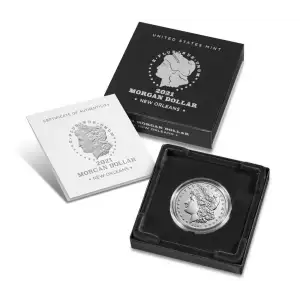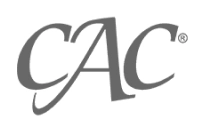Early 20th Century American 6-Coin Type Set // Relics of Bygone Era Series // Wood Presentation Box
Product Description:
This classic 6-coin set features some of the most famous designs to ever grace United States coinage during the first half of the 20th century. Each set includes one Indian Head cent, Buffalo nickel, Mercury dime, Standing Liberty quarter, Walking Liberty half dollar, and Peace silver dollar minted between 1900 and 1947. They span an era that witnessed two World Wars, the Roaring Twenties, the Great Depression, and the entirety of Prohibition. More than 70 to 120 years after their last mintage, these coins continue to be among the most beloved coins in American history. The coins for this special offer were hand-selected by professional numismatists after screening thousands of collectible coins for quality and eye-appeal. Each coin is housed in an airtight capsule and presented in a luxurious, plush-lined wood box with embossed metallic gold lettering, piano-black finish, and certificate of authenticity. The coins are unconditionally guaranteed to be genuine and will match the quality of the ones shown. If you are interested in building a collection, consider adding other great selections from the Relics of a Bygone Era Series to compliment your purchase, including the Late 19th and Early 20th Century Type Set.
About the Collection:
This classic 6-coin set features some of the most famous designs to ever grace United States coinage during the first half of the 20th century. Each set includes one Indian Head cent, Buffalo nickel, Mercury dime, Standing Liberty quarter, Walking Liberty half dollar, and Peace silver dollar minted between 1900 and 1947. The coins in this collection were hand-selected by professional numismatists after screening thousands of coins for quality and eye-appeal. They span an era that witnessed two World Wars, the Roaring Twenties, the Great Depression, and the entirety of Prohibition. More than 70 to 120 years after their last mintage, these coins continue to be among the most beloved coins in American history.
About the Indian Head Cent:
In the first half of the 18th century, one cent coins were large, clunky copper pieces nearly the size of a modern half dollar. By 1856, the cost of producing these copper coins rose so high that the U.S. mint was forced to significantly reduce the size of the one cent coin. On May 25th, 1857 the mint debuted a new small diameter cent, the Flying Eagle cent, which was the same size as our modern-day Lincoln cent. However, due to difficulties in production and issues with strike quality, this new cent was quickly abandoned and replaced by the Indian Head cent, which was minted through 1909. The obverse of the Indian Head cent features Lady Liberty wearing a Native American war bonnet— regarded by the public at the time as a decidedly unusual headdress for a female figure of otherwise neoclassical Greek form. The reverse originally featured an olive wreath, which was later changed to a wreath of oak and other leaves with a shield at the apex. Indian cents remained in circulation through the 1940s until increasing value and interest among coin collectors rendered them scarce by 1950.
About the Buffalo Nickel:
As part of a drive to beautify our nation’s coinage, President Taft commissioned artist James Earle Fraser to redesign the 5-cent piece. The result was the Indian Head or “Buffalo” nickel—an American icon that became one of the most widely collected coins of the 20th century. The new nickel embodied the spirit of the Old West, with an obverse design featuring an authentic composite portrait of three Native American subjects and an American Bison on the reverse. Unlike most prior U.S. coins that possessed abundant and smooth background fields, the Buffalo nickel was boldly filled with design elements stretching to all edges and set on an irregular background in bas-relief. Production continued until the design was replaced by the Jefferson nickel in 1938. Today, the Buffalo nickel is vanishingly scarce in circulation but lives on strongly in the hearts and cabinets of coin collectors and enthusiasts.
About the Mercury Dime:
Properly known as the “Winged Liberty” dime in the Mint’s official description, this popular coin features a stunning example of a youthful Lady Liberty on the obverse wearing a winged Phrygian cap to symbolize freedom of thought. However, this was publicly confused almost immediately after its release in October of 1916 with a likeness of the Roman God Mercury, and thus this coin’s enduring colloquial name was born. The reverse features the fasces carried by Roman magisterial lictors and symbolizes power and justice, as well as strength in numbers, and is accompanied by an olive branch of peace. The Mercury dime and its contemporaries included in this set collectively spanned an era that witnessed two World Wars, the Roaring Twenties, the Great Depression, and the entirety of Prohibition. It continues to be one of the most beloved coins in American history, more than 70 years after its last mintage in 1947.
About the Standing Liberty Quarter:
Much like the Mercury dime, the Standing Liberty quarter is a quintessential example of the “Renaissance” of American coinage. Released at the height of World War I, the obverse shows Lady Liberty facing right (towards the “Eastern” war), bearing an olive branch in her outstretched right arm and a shield in her left— representing a desire for peace but a distinct readiness for war. The reverse features an eagle in flight that is reminiscent of earlier classical U.S. coinage. Interestingly, this coin underwent a few design changes during its short 15-year production. Most notably, the original 1916 design featuring Lady Liberty with an exposed right breast was covered in chainmail armor by mid-1917. The precise reason for this abrupt modification is not entirely clear, but prevailing hypotheses include prudish public outcry over the exposed breast, requests by the United States Treasury, and symbolic incongruence— if Lady Liberty was ready for war, should she not be dressed for such occasion? Production continued through 1930, but no coins were issued in 1931 due to an unfortunate lack of need during the Great Depression. The design was replaced in 1932 by the Washington Quarter, which continues to grace our nation’s coinage today, albeit with modification.
About the Walking Liberty Half Dollar:
The Walking Liberty half dollar is yet another enduring classic engraved by Adolph A. Weinman, the designer of the Mercury dime. This graceful coin features Lady Liberty adorned in an American flag and striding towards the rising sun with her right arm outstretched, carrying branches of laurel and oak. The reverse features a powerful perched eagle with open wings and a sapling of Mountain Pine, symbolic of America. The design was exceptionally detailed compared to previous coins, which lead to persistent problems with sharpness of strike and production quality— accelerating its replacement by the Franklin half dollar in 1948. The lasting beauty of this unique design was immortalized in 1986 when the U.S. Mint chose to adopt the Walking Liberty obverse for the American Silver Eagle bullion coin, which has become one of the most widely distributed silver bullion coins in the world. Today, many Walking Liberty half dollar issues are scare in high grades and completion of an entire collection of these coins in uncirculated condition remains a formidable challenge for collectors and investors alike.
About the Peace Dollar:
The Peace dollar is often considered the most beautiful silver dollar ever minted by the United States. Following World War I, there was widespread sentiment to issue a coin to commemorate the restoration of peace. At the same, the U.S. Mint was required by the Pittman Act of 1918 to replace over 270 million silver dollars that had been melted. The federal Commission of Fine Arts held a competition and invited nine medalists to submit designs for the new dollar, including famed artists Victor D. Brenner, Herman A. MacNeil, and Adolph A. Weinman, who had already designed other circulating coins. The relatively inexperienced winner, however, was Anthony de Francisci—an Italian immigrant who modeled a depiction of Liberty after his young wife Teresa. On this stunning coin, Liberty wears a radiant crown like that worn by the Statue of Liberty, symbolizing the powers associated with the sun. The reverse features a resting eagle clutching an olive branch of peace and looking towards the sun’s rays. The word PEACE appears on a rock below the eagle, making the Peace dollar the only circulating coin in U.S. history to ever to bear that motto. Production continued until the requirements of the Pittman Act were satisfied in 1928. No dollars were minted from 1929-1933, as demand was low during the Great Depression. Limited production resumed in 1934 and 1935 for the redemption of paper silver certificates. The Peace dollar turned out to be the last true silver dollar ever minted for circulation in the United States. Sadly, its timely end came not 4 years before World War II and the end of world peace.
Product Details:
Coin 1:
Type: Indian Head Cent (1859-1909)
Variety: Copper (1864-1909)
Designer: James B. Longacre
Weight: 3.11 grams
Diameter: 19 mm
Composition: 0.950 copper, 0.50 tin and zinc
Obverse Design: Lady Liberty with feathered headdress, facing left
Obverse Inscription: UNITED STATES OF AMERICA / DATE
Reverse Design: Oak wreath and shield
Reverse Inscription: ONE CENT
Coin 2:
Type: Buffalo Nickel (1913-1938)
Designer: James Earle Fraser
Weight: 5 grams
Diameter: 21.2 mm
Composition: 0.750 copper, 0.250 nickel
Obverse Design: Bust of Indian Chief
Obverse Inscription: LIBERTY / DATE
Reverse Design: American Bison
Reverse Inscription: UNITED STATES OF AMERICA / E PLURIBUS UNUM / FIVE CENTS
Coin 3:
Type: Mercury Dime (1916-1947)
Designer: Adolph A. Weinman
Weight: 2.50 grams
Diameter: 17.9 mm
Composition: 0.900 silver, 0.100 copper
Net silver weight: 0.07234 oz pure silver
Obverse Design: Liberty with winged cap
Obverse Inscription: LIBERTY / IN GOD WE TRUST / DATE
Reverse Design: Fasces with axe / Olive branch
Reverse Inscription: UNITED STATES OF AMERICA / E PLURIBUS UNUM / ONE DIME
Coin 4:
Type: Standing Liberty Quarter (1916-1930)
Designer: Herman A. MacNeil
Weight: 6.25 grams
Diameter: 24.3 mm
Composition: 0.900 silver, 0.100 copper
Net silver weight: 0.18084 oz pure silver
Obverse Design: Lady liberty, facing right, with shield and olive branch, in wall gate
Obverse Inscription: LIBERTY / IN GOD WE TRVST / DATE
Reverse Design: EAGLE IN FLIGHT
Reverse Inscription: UNITED STATES OF AMERICA / E PLVRIBVS VNVM / QUARTER DOLLAR
Coin 5:
Type: Walking Liberty Half Dollar (1916-1947)
Designer: Adolph A. Weinman
Weight: 12.5 grams
Diameter: 30.6 mm
Composition: 0.900 silver, 0.100 copper
Net silver weight: 0.36169 oz pure silver
Obverse Design: Liberty wearing an American flag dress with outstretched arm and carrying branches of laurel and oak / Mountain with rising sun in distance
Obverse Inscription: LIBERTY / IN GOD WE TRUST / DATE
Reverse Design: Perched eagle with open wings carrying sapling of Mountain Pine
Reverse Inscription: UNITED STATES OF AMERICA / E PLURIBUS UNUM / HALF DOLLAR
Coin 6:
Type: Peace Dollar (1921-1935)
Designer: Anthony de Francisci
Weight: 26.73 grams
Diameter: 38.1 mm
Composition: 0.900 silver and 0.100 copper
Net silver weight: 0.77344 oz pure silver
Obverse Design: Liberty with radiant crown
Obverse Inscription: LIBERTY / IN GOD WE TRVST / DATE
Reverse Design: Eagle perched upon a rock with olive branch in talons / Sun rays
Reverse Inscription: UNITED STATES OF AMERICA / E PLURIBUS UNUM / PEACE / ONE DOLLAR


























